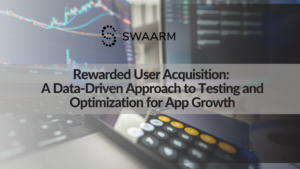In this article, originally published by Medianews4u, Yogeeta Chainani, CEO and Co-founder of Swaarm, talked about Data and why marketing agencies should integrate it from its source to the analytics destination.
There’s never been so much data available as of today. The internet went mainstream in 1991 and marketing pretty much stayed the same for the next decade and a half. However, the full emergence of big data in 2005 as a gold mine of business intelligence ushered in the next revolution in the marketing arena. According to IBM Marketing Cloud’s, “10 Key Marketing Trends For 2017,” 90% of the data in the world was created between 2015-17, at 2.5 quintillion bytes of data a day!
As we prepare to enter 2023, agencies can no longer afford to ignore this issue…
With marketers having access to all that data, the question of what to do with it and whether or not it can be done ethically, reliably, and efficiently still persists. While the answer is a definite yes, it is important to understand the reasons why a data problem exists in the first place; even before the ecosystem evaluates ways of managing its marketing data in a better way. Today’s business environment calls for more productive work instead of continuous copy-pasting and manual reporting. Not just in India but globally as well, many marketers continue to deal with scenarios ranging from an overload of data, it being scattered across platforms or manual compilation of reports. Marketers could gain the insights they need to make better business decisions instead of being in a situation of getting wrong data that might lead them down an unwanted path. Above all, the post-pandemic times call for ways to increase business revenue instead of leaving it to one’s competitors.
It’s time to delve into the issues with marketing data and adopt ways in which they can be fixed.
Let’s pause for a moment to understand the core issue with marketing data
One of the biggest challenges for marketers is figuring out how to deal with marketing analytics. According to The CMO survey (compiled by Deloitte, Duke Fuqua, and American Marketing Association) released in August 2018, only 30% of B2B marketers rely on analytics to make data-driven marketing decisions, primarily because of the complexities in managing marketing analytics. In fact, 50% of marketers acknowledged lacking resources and experiencing a skill shortage- the right people, processes, and technologies that could help them make use of all of that marketing data to make an impact.
There is also a major data explosion with too much data spread across way too many places or stored in tools that aren’t compatible with each other. No marketer would ideally like to copy-paste that data overload for creating so-called meaningful and actionable reports; and without data and analytics, marketers may just end up missing out on insights that would be crucial for the growth of the business.
In today’s dynamic martech environment, it is harder than ever for marketers to predict upcoming trends and successfully navigate significant changes in the market due to the deficit of accurate forecasts. Additionally, there is a lack of transparency and non-innovative solution providers struggle to provide Marketers with reliable tools to fully control their data and gain insights in real-time.
The answer is simple: marketers need to integrate their data from its source to the analytics destination they want to use. Automatically and reliably.
For marketing agencies, there is no solution that fits all
Every client has its own specific requirements when it comes to execution and measurement. In the current scenario, marketers need the flexibility to customize to their clients’ needs considering some of them may need monthly reports, daily updates, or even complex data modeling.
Agencies can leverage a mix of tools to address their data needs…
To begin with, it is important to invest in advanced tech and innovation for a brand-safe and fraud-free inventory. Additionally, agencies should focus on internal analysis which is a more time-consuming task, yet it is necessary to get the most out of the available data and identify market trends that can optimize performance.
Examples are galore to showcase how successful agencies benefit from transparency and collaborations. Advanced tech supports this in significant ways..let’s understand how…
- Advanced tech enables partner marketers to offer an inventory that is fraud-free and brand-safe. New-age martech platforms offer fraud filter features that empower marketers to offer their partners more insights into their campaigns and protect them against fraudulent traffic. Agencies can audit and select high-quality publishers, easily keeping track of the quality of offers. Due to its ease of attribution and transparent approach, this type of fraud-free partnership can be a powerful yet cost-effective approach. It also drives vertical-specific traffic in high volumes globally, positively impacting ROI.
- Agencies get the opportunity to slice and dice their campaigns with more flexibility, easily distributing and accepting offers. They can manage more high-volume requests, making performance marketing more efficient and scalable. Advertisers can benefit from data-driven optimization, based on granular targeting options powered by machine learning. Many advanced reporting tools provide the ability to slice and dice data as needed, gaining access to critical insights for daily operations at a humanly impossible speed. This helps to stay on track and detect potential issues that could affect the businesses’ revenue as early as possible.
- Agencies can scale campaigns with a more international reach. Features like offer testing and automated insights enable you to import, create and accept offers from a vast number of integrated partners based on predefined rules, thereby saving tons of time and resources. They also help to easily spot trends and patterns.
The way forward prior to stepping into 2023 should be enabled by the right tools. We are living in a world of increased data privacy and will have to focus on building the capacity of a stable and reliable data stack. While managing the exhaustive repository of data will be challenging, agencies need to invest in the right products, and partner with technology expert tracking platforms to be able to move forward on their data journey – sans any insecurity or worry about moving their data to where they need it in a secure and reliable manner. It is time to reap the most out of 2023 and focus on what matters most- after all, it is now possible to make sense of the data mayhem.
This article was originally published on Medianews4u.com.



